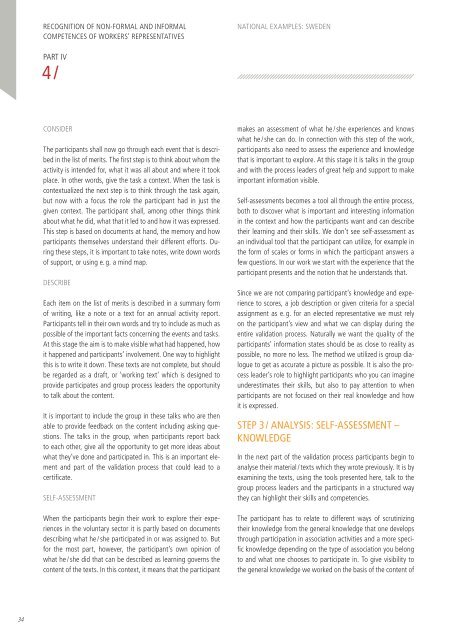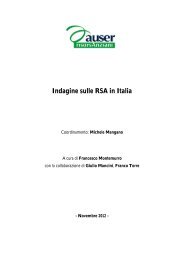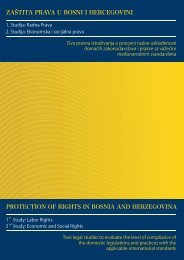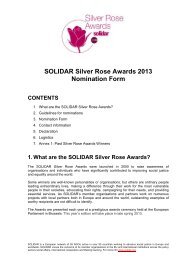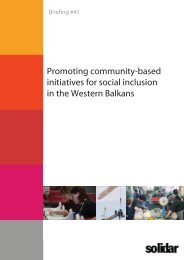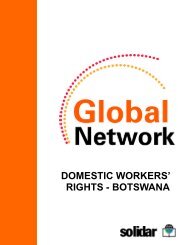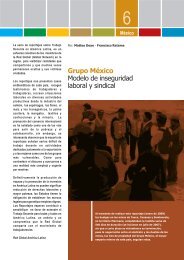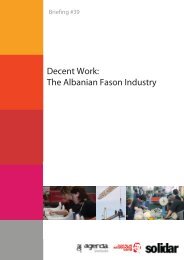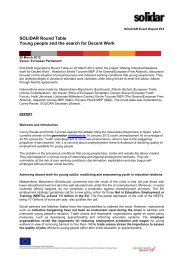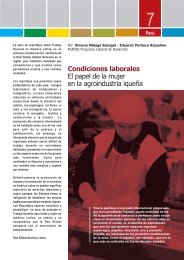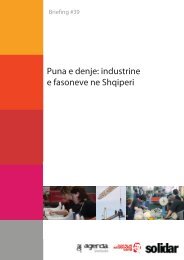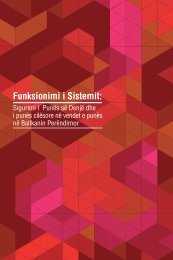RECOGNITION OF NON-FORMAL AND INFORMAL ... - Solidar
RECOGNITION OF NON-FORMAL AND INFORMAL ... - Solidar
RECOGNITION OF NON-FORMAL AND INFORMAL ... - Solidar
You also want an ePaper? Increase the reach of your titles
YUMPU automatically turns print PDFs into web optimized ePapers that Google loves.
<strong>RECOGNITION</strong> <strong>OF</strong> <strong>NON</strong>-<strong>FORMAL</strong> <strong>AND</strong> IN<strong>FORMAL</strong><br />
COMPETENCES <strong>OF</strong> WORKERS’ REPRESENTATIVES<br />
NATIONAL EXAMPLES: SWEDEN<br />
PART IV<br />
4 /<br />
CONSIDER<br />
The participants shall now go through each event that is described<br />
in the list of merits. The fi rst step is to think about whom the<br />
activity is intended for, what it was all about and where it took<br />
place. In other words, give the task a context. When the task is<br />
contextualized the next step is to think through the task again,<br />
but now with a focus the role the participant had in just the<br />
given context. The participant shall, among other things think<br />
about what he did, what that it led to and how it was expressed.<br />
This step is based on documents at hand, the memory and how<br />
participants themselves understand their different efforts. During<br />
these steps, it is important to take notes, write down words<br />
of support, or using e. g. a mind map.<br />
DESCRIBE<br />
Each item on the list of merits is described in a summary form<br />
of writing, like a note or a text for an annual activity report.<br />
Participants tell in their own words and try to include as much as<br />
possible of the important facts concerning the events and tasks.<br />
At this stage the aim is to make visible what had happened, how<br />
it happened and participants’ involvement. One way to highlight<br />
this is to write it down. These texts are not complete, but should<br />
be regarded as a draft, or ‘working text’ which is designed to<br />
provide participates and group process leaders the opportunity<br />
to talk about the content.<br />
It is important to include the group in these talks who are then<br />
able to provide feedback on the content including asking questions.<br />
The talks in the group, when participants report back<br />
to each other, give all the opportunity to get more ideas about<br />
what they’ve done and participated in. This is an important element<br />
and part of the validation process that could lead to a<br />
certifi cate.<br />
SELF-ASSESSMENT<br />
When the participants begin their work to explore their experiences<br />
in the voluntary sector it is partly based on documents<br />
describing what he / she participated in or was assigned to. But<br />
for the most part, however, the participant’s own opinion of<br />
what he / she did that can be described as learning governs the<br />
content of the texts. In this context, it means that the participant<br />
makes an assessment of what he / she experiences and knows<br />
what he / she can do. In connection with this step of the work,<br />
participants also need to assess the experience and knowledge<br />
that is important to explore. At this stage it is talks in the group<br />
and with the process leaders of great help and support to make<br />
important information visible.<br />
Self-assessments becomes a tool all through the entire process,<br />
both to discover what is important and interesting information<br />
in the context and how the participants want and can describe<br />
their learning and their skills. We don’t see self-assessment as<br />
an individual tool that the participant can utilize, for example in<br />
the form of scales or forms in which the participant answers a<br />
few questions. In our work we start with the experience that the<br />
participant presents and the notion that he understands that.<br />
Since we are not comparing participant’s knowledge and experience<br />
to scores, a job description or given criteria for a special<br />
assignment as e. g. for an elected representative we must rely<br />
on the participant’s view and what we can display during the<br />
entire validation process. Naturally we want the quality of the<br />
participants’ information states should be as close to reality as<br />
possible, no more no less. The method we utilized is group dialogue<br />
to get as accurate a picture as possible. It is also the process<br />
leader’s role to highlight participants who you can imagine<br />
underestimates their skills, but also to pay attention to when<br />
participants are not focused on their real knowledge and how<br />
it is expressed.<br />
STEP 3 / ANALYSIS: SELF-ASSESSMENT –<br />
KNOWLEDGE<br />
In the next part of the validation process participants begin to<br />
analyse their material / texts which they wrote previously. It is by<br />
examining the texts, using the tools presented here, talk to the<br />
group process leaders and the participants in a structured way<br />
they can highlight their skills and competencies.<br />
The participant has to relate to different ways of scrutinizing<br />
their knowledge from the general knowledge that one develops<br />
through participation in association activities and a more specifi<br />
c knowledge depending on the type of association you belong<br />
to and what one chooses to participate in. To give visibility to<br />
the general knowledge we worked on the basis of the content of<br />
34


